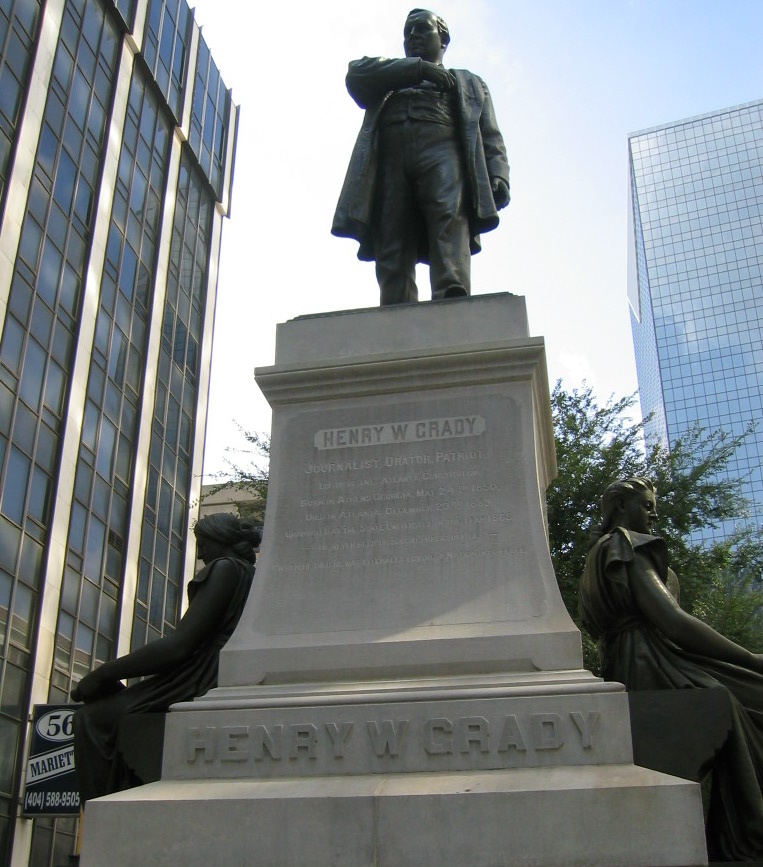The escalating fight over racist monuments in Southern communities

Students at Georgia State University are calling for the removal from an Atlanta public square of a statue of Henry W. Grady, seen here, a prominent newspaper publisher who held white-supremacist beliefs and opposed equality for African Americans in the late 19th century. (Photo by Roger3b via Wikipedia.)
Earlier this month, Nikki Haley, the former Republican governor of South Carolina, wrote an op-ed in the Washington Post defending the Confederate flag as a symbol of tradition and heritage for many Americans.
"Everyone knows the flag has always been a symbol of slavery, discrimination and hate for many people. But not everyone sees the flag that way," wrote Haley, reflecting on her experience leading the successful effort to remove the flag from the South Carolina statehouse grounds following the 2015 massacre of nine black parishioners at Mother Emanuel Church in Charleston by a Confederate flag-waving white supremacist. "That's hard for non-Southerners to understand, but it's a fact. There are a small number of hardened white supremacist racists who proclaim the flag as their symbol."
Critics counter that Haley is presenting an inaccurate history that ignores the long association between racial terror and Confederate symbols. They include Adam Domby, an assistant professor of history at the College of Charleston and author of "The False Cause: Fraud, Fabrication, and White Supremacy in Confederate Memory." As he wrote in an op-ed responding to Haley, "The white-supremacy movement did not hijack the memory of the Confederacy; in many ways, the modern white-supremacist movement evolved out of the failed Confederate movement."
After the end of the Civil War, the Confederate flag as well as monuments honoring the Confederacy and those who opposed racial equality became more popular even as resistance to racial discrimination and Jim Crow segregation grew. Historians say the increased visibility of Confederate symbols was clearly meant to send a message of preserving the racial order. As James Grossman, the executive director of the American Historical Association, put it: "These statues were meant to create legitimate garb for white supremacy."
The Southern Poverty Law Center currently estimates that more than 1,700 "publicly sponsored symbols" of the Confederacy remain in place nationwide, including statues, flags, official observances, and place names. Since the Charleston massacre, 114 Confederate symbols have been removed. However, seven Southern states have laws in place that aim to prevent cities and counties from removing them: Alabama, Georgia, Mississippi, North Carolina, South Carolina, Tennessee, and Virginia. Four other states — Florida, Kentucky, Louisiana, and Texas — have considered but have not passed such laws.
Nevertheless, communities in these states and others across the South are engaged in efforts to confront the violent history of Confederate and other racist symbols and remove them from public spaces.
Funding white supremacy
Last month, following decades of protests over the "Silent Sam" Confederate monument at the University of North Carolina at Chapel Hill that anti-racist protesters tore down last year in defiance of the state's monument-protection law, the UNC Board of Governors agreed to a controversial settlement that gives the state chapter of the Sons of Confederate Veterans (SCV) all rights to the statue, bans the monument from any of the 14 counties with a UNC institution, and creates a $2.5 million trust for the monument's preservation. University officials argued that the settlement was the best way to avoid legal action by the Confederate group, but students, faculty, and community members have expressed outrage at the deal, which was negotiated outside of public view. "The settlement will help the Sons of Confederate Veterans perpetuate the ahistorical and dangerous 'Lost Cause' ideology," said De'Ivyion Drew, a UNC-Chapel Hill sophomore.
Drew is one of the students represented in a lawsuit against the settlement brought by the Lawyers' Committee for Civil Rights Under Law. The group wants the settlement put on hold, arguing that the UNC system and the Confederate group "colluded to defraud the Court on the issue of standing." The monument was given to the university in 1913 by the United Daughters of the Confederacy; days before the settlement was reached, the UDC gave the SCV state chapter rights to the monument, which the Lawyers' Committee claims it never had in the first place.
"We stand with the students and faculty in condemning this deeply flawed settlement that finds the UNC system complicit in financing white supremacist activity," said Kristen Clarke, the group's president and executive director.
Meanwhile in Georgia, students at Georgia State University earlier this month called for the removal of a statue of Henry W. Grady from an Atlanta public square, also named for Grady, in an editorial published by the student newspaper. Grady was the managing editor of the Atlanta Constitution and a central figure in the city's politics during the late 19th century who supported a white supremacist's campaign for governor, published racist headlines, and opposed voting rights for African Americans. "The supremacy of the white race of the South must be maintained forever and the domination of the negro race resisted at all points and at all hazards because the white race is the superior race," Grady said in an 1888 speech on the "New South."
The Grady monument and others like it are protected under a Georgia law that was passed earlier this year. It states that no publicly-owned monument "shall be relocated, removed, concealed, obscured, or altered in any fashion by any officer or agency." The students' ultimate goal is relocating the monument, but given the law for now they are fighting to have an explanatory plaque placed next to the statute. "We do not advocate for the destruction of this monument, as we reject the practice of attempting to erase or conceal our past," the students wrote, "but we do advocate for the placing of this monument within historical context and absent of civic reverence."
And in Alabama, the state Supreme Court last month ruled that the city of Birmingham, which is now majority black, violated a state law in 2017 when officials ordered plywood screens be placed around a monument honoring Confederate veterans. The Alabama Memorial Preservation Act prevents local governments from removing or destroying historical markers and monuments.
The unanimous decision by the all-Republican court reversed a ruling by a lower court that sided with the city, ruling that Alabama's law violated its right to free speech. "Just as the state could not force any particular citizen to post a pro-Confederacy sign in his or her front lawn, so too can the state not commandeer the city's property for the state's preferred message," Judge Michael Graffeo wrote. But last month the Alabama Supreme Court said the lower court misjudged when it ruled that the city had constitutional rights to free speech and ordered that the city be fined $25,000 for violating state law.
City spokesperson Rick Journey said officials were "strongly disappointed" with the decision and are considering next steps.
Tags
Benjamin Barber
Benjamin Barber is the democracy program coordinator at the Institute for Southern Studies.
